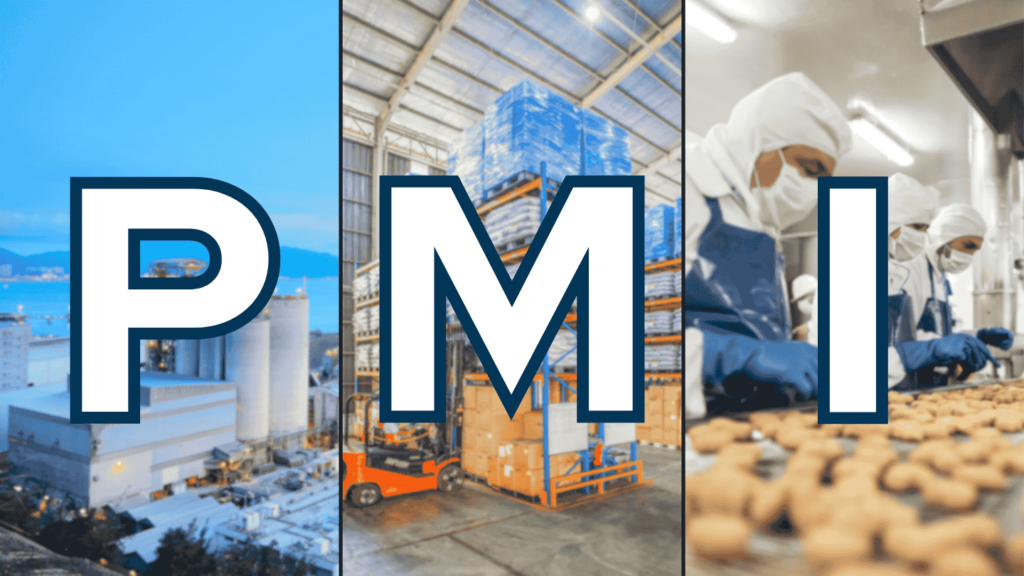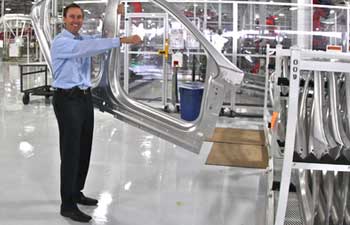Manufacturing PMI Definition and Insights for SMEs
The Manufacturing PMI is a vital economic metric that indicates whether the manufacturing industry is experiencing an expansion, a contraction, or a standstill. It provides growing manufacturers with valuable insights and helps prepare for market changes.

What is the Manufacturing Purchasing Managers’ Index (PMI)?
The Manufacturing Purchasing Managers’ Index (PMI) is an economic metric reported by the Institute for Supply Management (ISM) to assess the manufacturing industry’s health. It is derived from monthly surveys of purchasing managers in manufacturing companies and indicates whether the market is expanding, contracting, or static.
The survey covers five key components:
- New orders. Measures the volume of new orders, reflecting demand for goods.
- Production. Captures changes in production levels, indicating manufacturing activity.
- Employment. Tracks hiring or layoffs within the sector.
- Supplier lead times. Monitors whether deliveries from suppliers are faster or slower than in the previous month.
- Inventory. Evaluates changes in the stock levels of goods held by manufacturers.
The index is presented as a number on a scale from 0 to 100. A PMI below 50 indicates a decrease in manufacturing activity, a PMI above 50 indicates an increase, and 50 suggests no change in activity compared to the previous month. The wider the gap between the current PMI and 50, the better or worse the result.
Why is the manufacturing PMI important?
The manufacturing PMI indicates the current state of the manufacturing sector and as such, it is both a vital metric for gauging the overall health of the wider economy and a point of consideration when making business plans. Here are some useful ways the manufacturing PMI can help you keep your business on the right course:
Influence on business planning
A rising PMI suggests that demand for manufactured goods is increasing. On the other hand, a PMI drop may signal a slowdown in the economy. By monitoring PMI trends, businesses can prepare for expansion or brace for a contraction, allowing them to adjust their operations proactively. For example, expanding your workforce and product portfolio and investing in expensive machinery or tech is more reasonable in a period of positive PMI, while during a contraction, businesses should try to keep their operational costs in check and delay large non-essential investments.
Highlights potential supply chain disruptions
Monitoring the supplier lead times component of the PMI could give you an early warning of an impending supply chain disruption. A slowdown in deliveries could signal bottlenecks, shortages, or rising transportation costs in the supply chain, and catching this early may allow you to navigate the disruptions better.
Provides insights into staffing
The employment component of the manufacturing PMI provides useful insights into the job market of the manufacturing sector. During a period of layoffs, companies unaffected by the contraction may benefit from a better selection of possible new hires, while during periods of increased hiring activity, companies need to invest more in attracting talent.
Strategies for periods of positive PMI
Do:
- Ramp up production. Increasing your production capacity allows you to meet rising demand and capture a larger market share. However, ensure that production increases align with demand forecasts to avoid overproduction and excess inventory.
- Invest in new technology. Implementing manufacturing ERP software or adding machinery can boost administrative and production efficiency, preparing your business for long-term growth.
- Expand your product portfolio. Diversifying your offerings can help attract new customers and reduce dependence on a single product line.
- Widen the marketing scope. Use increased demand as an opportunity to reach new markets and customers. Expanding marketing efforts can drive brand awareness, increase sales, and position your business as a leader in the industry.
- Negotiate favorable terms with suppliers. Leverage the positive economic environment to secure better pricing, bulk discounts, or flexible terms. Locking in these benefits sooner rather than later can protect your business when the market slows.
- Build financial reserves. Use the high-revenue period to build a financial buffer that can help you weather future market cooling.
Don’t:
- Overextend. Avoid rapid expansion that stretches your resources too thin, as this can make scaling back difficult in a downturn. Focus on steady, sustainable growth to reduce risk.
- Neglect cost control. Even during growth, maintaining a disciplined approach to expenses will maximize profitability.
- Postpone process improvements. Don’t delay implementing software and optimizing your operations for efficiency, as process improvements can increase productivity and reduce costs in the long term.
- Accumulate excess inventory. Stockpiling too much inventory ties up capital and increases storage costs, especially if demand fluctuates. Aim to align inventory with real demand forecasts.
- Create dependence on single suppliers. Relying heavily on one supplier exposes you to potential disruptions if that supplier faces issues. Diversify your supply base to minimize risks and ensure consistent production.
- Overhire. Adding too many permanent staff to handle peak demand can increase costs if demand tapers off. Instead, consider hiring temporary staff or cross-training existing employees to stay agile.
- Assume growth will last forever. Always prepare for potential downturns. Establish flexible strategies to adapt to market changes and maintain stability if demand declines.
Strategies for periods of negative PMI
Do:
- Optimize processes. Reduce waste, improve efficiency, and lower costs. Small process improvements can lead to significant cost savings and help your business maintain profitability.
- Implement budget-friendly technology. Look for cost-effective software such as cloud-based manufacturing ERP, or affordable equipment upgrades that improve productivity. Budget-friendly targeted tech investments can help reduce costs during slower periods.
- Control and reduce costs. Assess all expenditures to identify non-essential costs that can be reduced or eliminated. Cost controls help protect cash flow and create a leaner and more resilient business.
- Adjust inventory levels. Align inventory with current demand to avoid excess stock and free up capital. Reducing inventory costs can help keep cash flow healthy during slow periods.
- Improve marketing targeting. Focus on reaching the most profitable customer segments to maintain a steady revenue stream. A targeted marketing approach can improve conversion rates even in a market downturn.
- Invest in high-impact areas. Allocate resources to areas with high returns potential, like product quality or customer service.
- Avoid unnecessary debt. During downturns, limit new debt to avoid burdensome repayments if revenue decreases.
Don’t:
- Neglect marketing. Cutting marketing costs can hurt brand visibility and make it difficult to regain market share later. Consider scaling down but keep core marketing efforts active to maintain customer engagement.
- Cut key investments. Avoid completely cutting investments in essential areas like technology and process improvement, as they can keep your business efficient and competitive. Strategic, minimal investments can set you up for future growth.
- Sacrifice quality and customer service. Reducing quality or customer support can damage your reputation and erode customer loyalty. Maintaining high standards is crucial to retaining customers during challenging times.
- Panic-hire or panic-layoff. Rapid hiring or layoffs can disrupt productivity and morale. Use careful workforce planning to adjust staffing levels gradually and strategically.
- Focus solely on immediate survival. While managing short-term challenges is crucial, don’t lose sight of your long-term strategy. Balancing short-term actions with a forward-looking plan prepares your business to capitalize on future recovery opportunities.
Benefits of MRP software during negative PMI
Manufacturing resource planning (MRP) software can be a major help for manufacturers when trying to weather periods of negative PMI. When manufacturing activity slows and cost control becomes a priority, it helps businesses balance production capacity with shifting demand, optimize processes, reduce waste, and keep track of manufacturing costs. MRP systems also enable precise inventory management, allowing companies to reduce stock levels and avoid tying up direly needed cash in excess inventory.
Benefits of MRP software during positive PMI
In addition to helping businesses stay flexible during negative PMI, MRP software is also essential for scaling production processes during periods of growth. With real-time data on inventory levels, production schedules, and supplier lead times, MRP systems enable manufacturers to ramp up production confidently without risking overstocking or bottlenecks. It provides a complete overview of a manufacturing operation, making sure that materials are ordered at the right time, that your production capacity is aligned with demand, and that product quality is kept at a high standard.
US manufacturing PMI
source: tradingeconomics.com
UK manufacturing PMI
source: tradingeconomics.com
Euro area manufacturing PMI
source: tradingeconomics.com
Australia manufacturing PMI
source: tradingeconomics.com
Key takeaways
- The Manufacturing PMI is a key economic metric that reveals whether the manufacturing sector is growing, contracting, or remaining stable. By monitoring PMI trends, manufacturers gain early insights into economic shifts, enabling more proactive business planning.
- In positive periods, manufacturers may consider scaling production and investing in growth, while in negative periods, they can focus on cost control and efficiency.
- The supplier lead time component of the PMI provides early warnings of potential supply chain issues. Slower supplier deliveries might indicate shortages or logistical bottlenecks, allowing businesses to respond strategically and reduce disruption risks.
- The employment component of the PMI offers valuable labor market insights. During periods of contraction, there may be opportunities to attract skilled talent, while during growth, businesses may need to focus on competitive hiring and retention strategies.
- In expansionary periods, MRP software supports manufacturers by optimizing inventory, automating procurement, and managing production capacity in real time, allowing businesses to meet demand effectively without risking overstock or bottlenecks.
- During economic slowdowns, MRP software helps manage inventory levels to avoid excess stock, track costs meticulously, and optimize production schedules, enabling businesses to reduce costs, maintain cash flow, and operate efficiently in challenging times.
Frequently asked questions
While the manufacturing PMI measures the health of the manufacturing sector, the services PMI reflects activity in the services sector, including finance, retail, and hospitality. Both indices provide insights into economic trends but are tailored to their respective industries.
Central banks consider PMI trends when setting interest rates, as rising PMI often signals economic growth that could lead to inflation. If PMI is high, rates may increase to control inflation, while low PMI could prompt rate cuts to stimulate growth.
While PMI is primarily a snapshot of current manufacturing health, trends in leading indicators, such as consumer demand and raw material prices, can provide hints of future PMI shifts. Businesses can monitor these factors to anticipate changes and adapt strategies proactively.
You may also like: 5 Most Common Small Manufacturing Challenges According to Consultants




